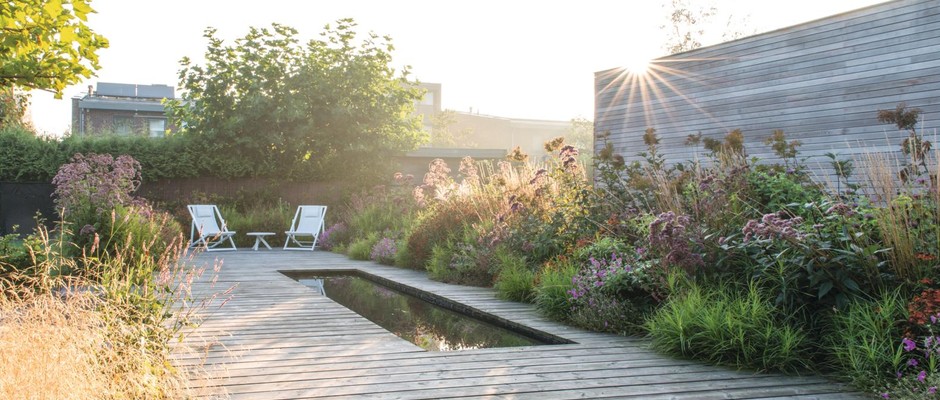
Design ideas for ponds and pools in the garden
Ideas for adding a pond or swimming pool to your garden, whatever its size, plus planting ideas and inspiration for hard landscaping materials
Water is an asset in any garden. Water features can mask noise pollution and create a strong sense of place. Larger bodies of water can tie the garden to its exterior landscape and smaller pools and rills can enhance the atmosphere of an outdoor space. Ponds are becoming ever more popular in gardens. They are a calming influence and, at their best, look entirely natural.
But, whether you want somewhere to swim, a natural pond or reflective pool you'll need hardscaping to match and below you'll find practical information on how to line your pond and planting advice. Plus, three inspiring gardens that have incorporated a pool or pond into the design in a beautiful and considered way demonstrating that there is a water feature for every style and space.
Practical considerations for introducing a pond or pool into the garden
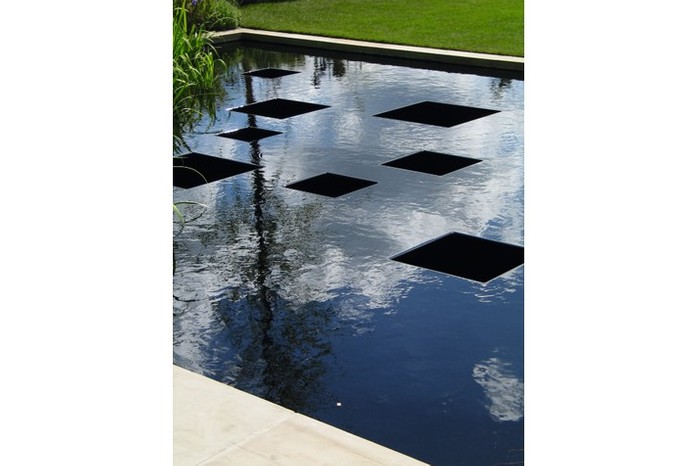
- It is important to disguise and cover the liners as they emerge from ponds and pools. Firstly, this is unsightly and, secondly, exposure to sunlight can weaken and damage the material, which becomes more prone to leakage.
- Keep pond shapes simple so that excavation is easier. Introduce planting to create visual interest and a naturalistic quality. Complex shapes often produce shallower and narrower water, which will silt up and warm quickly in sunlight.
- Butyl rubber is available in sheet form but can be glued or welded to create large-scale pools. With larger ponds, be aware of the local water table. If this varies dramatically, pressure from a rising water table can force water out of a lined pond. Liners can then be vented to allow pressures to be equalised.
- Don’t install lighting within a pool. This will reveal the lining, wiring, pump and detritus within the pool. Instead, light objects or planting on the far bank. Their reflection will be seen on the surface of the water after dark creating a more dramatic result.
- Existing streams and rivers cannot be dammed or altered. The Environment Agency is responsible for all watercourses and must be contacted before any work is considered. In general, create separate, self-contained ponds that do not overflow into nearby watercourses.
- Sunlight can create problems in ponds and water features in terms of solar gain, but it would be more problematic to site water in heavy shade. Sunlight brings life to water but does need to be controlled with careful planting allied with a good pool size and depth.
Planting for ponds
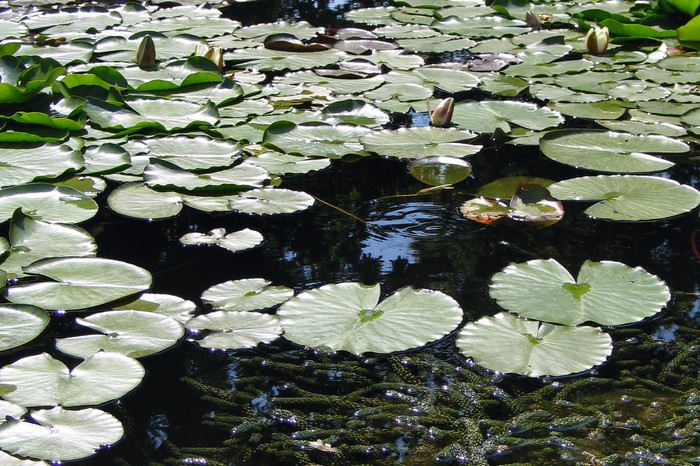
Plants look attractive in a pond, but they also counteract the warming effect of sunlight. Water lilies in particular create rafts of shade. Some plants, however, prefer deeper water than others. Water lilies may prefer 10cm of water or 150cm, depending on the cultivar. With this in mind, a pool intended for a range of water planting types needs to include several changes of depth. It is often useful and less time-consuming to excavate a hole, line it and then add changes of depth.
In concrete pools, the creation of these planting shelves, or pockets, is relatively easy – simply build up blocks on the solid pool base. If you are using butyl as your lining, make a concrete ‘pad’ or footing, lay the liner over it and add your block-work on top. As a precaution, lay a geotextile (a protective fabric) over the footing, before the butyl liner, to prevent stones from puncturing the liner. An additional layer of geotextile used over the liner allows walls to be constructed on top without damaging the butyl.
More like this
Try to create a sudden change of level between reed beds or marginal planting and the pool base. As the plants die back, a layer of detritus builds each year. A shallow bank profile allows the plants to colonise this layer and spread into open water, a process prevented or at least slowed if the shallow part of your pool suddenly drops to the base. Planting baskets will restrict the spread of more aggressive growers.
Ideas to steal from three beautiful gardens with pools
A pool garden for an awkward space
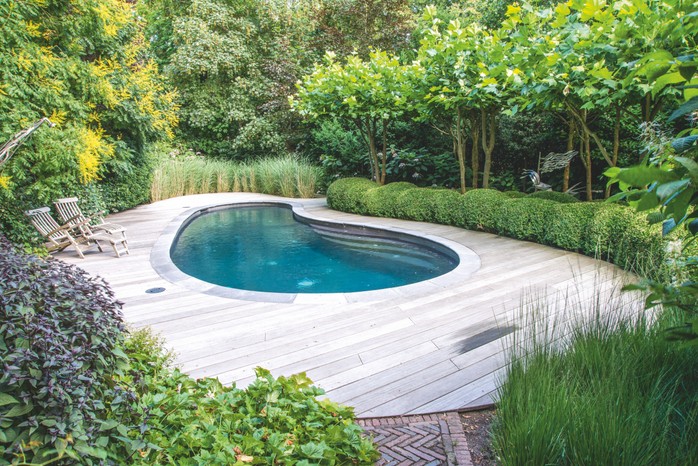
Garden designer Bart Hoes transformed an awkward triangular plot at the east end of a Dutch garden into a a pool garden. The curvy lines of the organically shaped pool are echoed in its steps and the surrounding balau decking. To the rear of the pool, soft clumps of Miscanthus sinensis 'Gracillimus' contrast with the structure of the cloud-pruned box and create a naturalistic feel to the planting
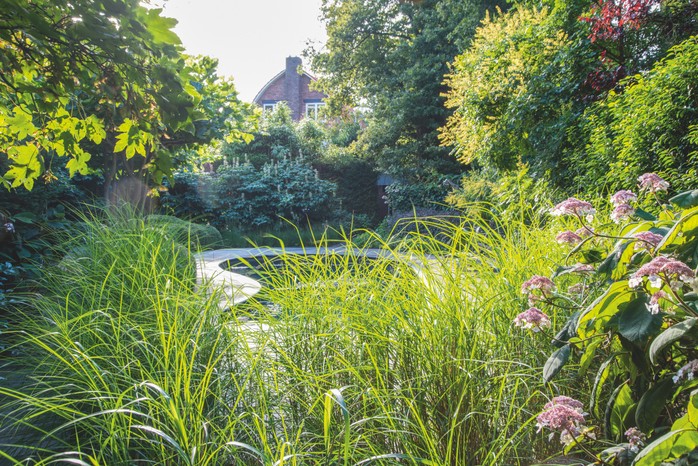
Clumps of the grass Miscanthus sinensis 'Gracillimus' and the shrub Hydrangea aspera 'Macrophylla' help shield a seating area from the pool.
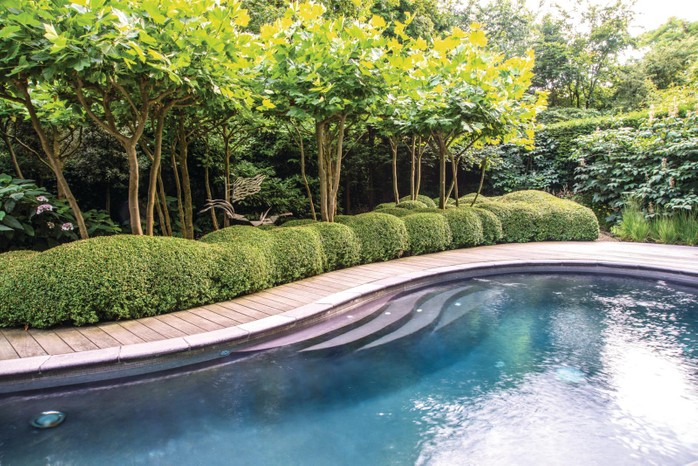
Bart has given the sides of the pool a grey finish to deepen the colour of the water, and to link the pool to the surrounding hard-wood decking. Buxus semperivirens, cloud-pruned to echo the pools curves, and dotted with multi-stemmed Platanus x hispanica, creates a soft-edged feel in this awkward, triangular plot. Nestled in among the trees is a sculpture by Jan Jacobs Mulder called Zuidenwind, which translates as southerly wind.
Bart Hoes five key points for designing a pool garden
- Materials
Using concrete when building a pool gives you an unlimited freedom of design. For the area around the pool, Bart recommends using splinter-free decking, which can be cut into any shape and it does not get as hot underfoot as tiles. - Colour
A grey finish on the pool’s inside provides a much more coherent and natural look in a verdant garden than the standard blue. The darker you go, the more of a ‘pond’ rather than a ‘pool’ effect you get. - Planting
The old adage of ‘no deciduous trees around a pool’ no longer applies, thanks to technological innovations, such as skimmers and robot vacuums, that get rid of leaves and debris. By bringing planting up to the pool’s edge, you can alter even further the visual impact of the pool’s shape. - Shape
Although your plot may dictate the pool’s area, it does not necessarily dictate its shape. Nowhere in this garden do you feel you are on a triangular plot. You can make a round plot look rectangular and vice versa, by choosing the pool shape you like and then blurring the outer boundaries with shrubs and trees. - Layering
When designing a pool garden, think vertically. The water surface is always flat, so is the area surrounding the pool. If you line that with walls of tall trees, the effect is one of a box dug into another box. Plant a transitional, medium-height layer, such as shrubs or multi-stemmed trees.
A swimming pool without boundaries
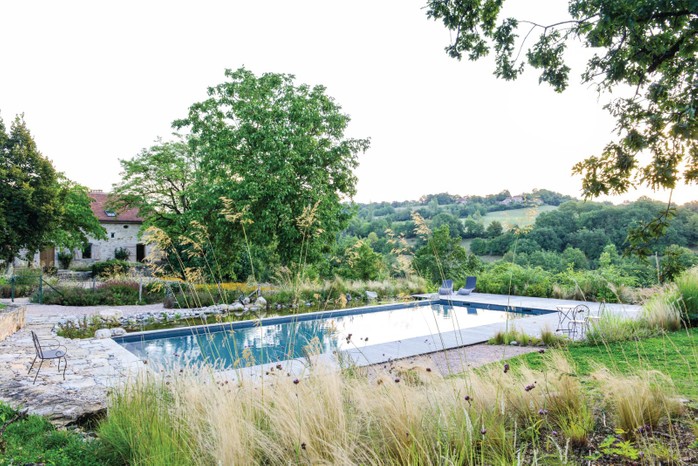
The pool at Mas del Lum was a conventional swimming pool until Yolande converted it with the help of designers Tom de Witte and Corrine Lecluyse of Omna Lanscape. A separate planting area was added to act as a filter and the water pumped between this ‘cleaning area’ and the swimming area. Keeping the areas separate made this an easy option for adapting a chemical pool without having to completely restructure and redesign this part of the garden.
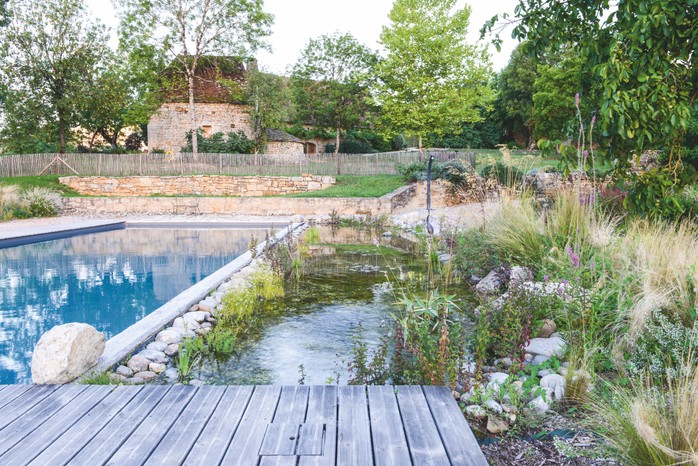
The planting area is lined with pebbles and planted with iris, reeds, mints and other aquatic plants, which are not grown in soil but anchored by their roots into the cobbles, pebbles and gravel that form the base. Not only do the plants take up nutrients that would otherwise cause algae to flourish, but they also give the pond its own ecosystem – attractive to visiting wildlife – and help it blend in with the garden.
It is like swimming through silk. There are times when the water looks a bit green, particularly after a thunderstorm. It is still safe to swim in, but it doesn’t look as attractive as the crystal clear water we usually have.
To ensure that the water does look sparkling for her bed-and-breakfast guests, Yolande has also installed a non-chemical cleaning system to back up the activity of the plants. Any debris from the surface of the water is skimmed off and the water passed through a series of filters that quickly remove nutrients and algae.
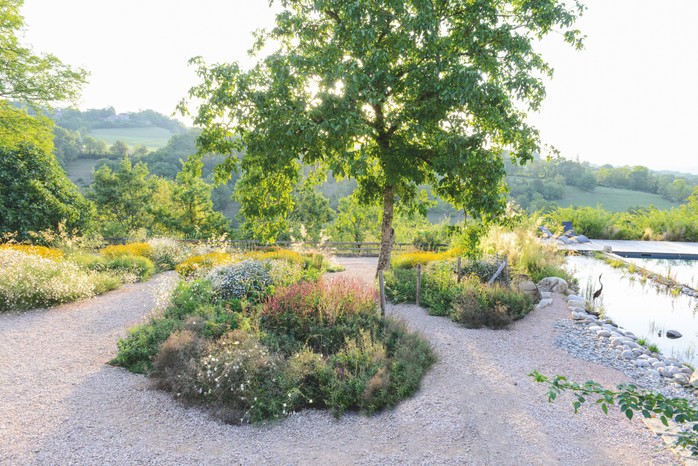
Close to the pool, beds of perennials and grasses are planted to mimic the contours of the surrounding hills and valleys.
A mirror pool for a small garden
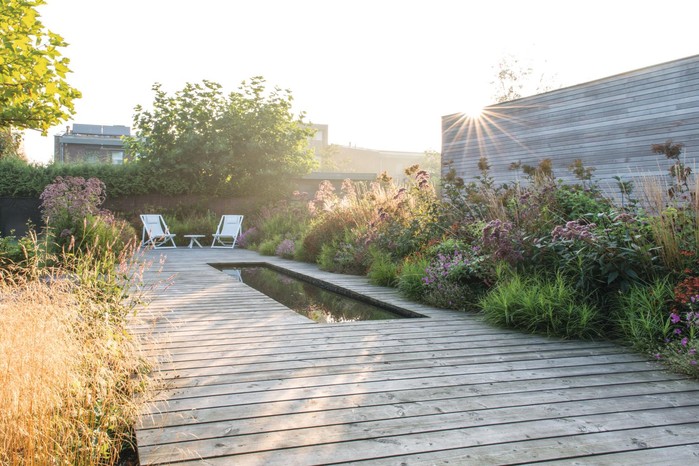
Space and budget often challenges the dream of a full-length private swimming pool, but this 6m-long sunken mirror pool, designed by Frank Heijligers of the garden design firm and nursery Van Nature, offers a solution to bringing the beauty of water to a small space. A naturalistic mix of ornamental grasses, including Deschampsia cespitosa 'Goldtau', and perennials, such as Eupatorium macilatum Atropurpureum Group and Geranium Patricia (= 'Brempat'), soften the pool's geometric lines.
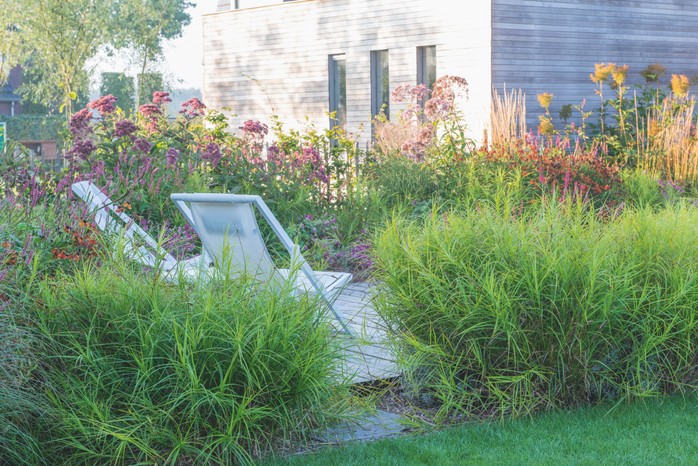
A soft wall of the mid-height grass Carex muskingumensis, separates the pool terrace from a large lawn to the side. The orange flowers of Helenium 'Moerheim Beauty' work wonderfully with the grass and bring the pinks of Eupatorium maculatum Atropurpureum Group and Persicaria amplexicaulis 'Firetail' to life.

Cocooned by planting, the pool terrace has a deeply relaxing feel. The Douglas fir decking blends beautifully with the floor tiles for the covered pavilion by the house. An outdoor fireplace allows the family to enjoy the garden on cooler days.
Frank Heijligers' five key points for planning a mirror pool
- Position Think carefully about the most suitable position for your pool. Ideally, you want a spot where you’ll be able to sit by it in summer, but where it will also form a relaxing focal point from inside the house – this is where you’ll probably be looking at it for much of the year. Bear in mind the main views from your home and also the architecture of your house.
- Safety A sunken mirror pool generates a wonderful reflective and relaxing effect, but isn’t always practical when you have very small children or pets. To avoid accidents consider a raised pool. Corten steel or zinc troughs can look very effective.
- Design A mirror pool requires less maintenance than a natural pond, but it also demands well-designed furniture that’s both comfortable to sit in and is interesting to look at.
- Cost Installing a mirror pool can be expensive. Depending on the size, materials and whether or not you want it to contain fish, it can cost from around £180 to the tens of thousands. You can reduce costs if you keep the design simple and, like Paul, you’re happy to dig it out yourself.
- Size A pool is an asset in any garden, large or small, and can also enhance the sense of space – a rectangular pond makes a small garden look bigger. Dare to make a statement and don’t shy away from a generous size.

Niwaki bundle worth £57 when you subscribe
Subscribe to Gardens Illustrated magazine and claim your Niwaki bundle worth £57
*UK only

Container Gardening Special Edition
The Gardens Illustrated Guide to Container Gardening.
In this special edition, discover colourful flower combinations and seasonal planting schemes for pots designed by leading plantspeople, and essential know-how for container gardening success. Just £9.99 inc UK p&pBy entering your details, you are agreeing to our terms and conditions and privacy policy. You can unsubscribe at any time.
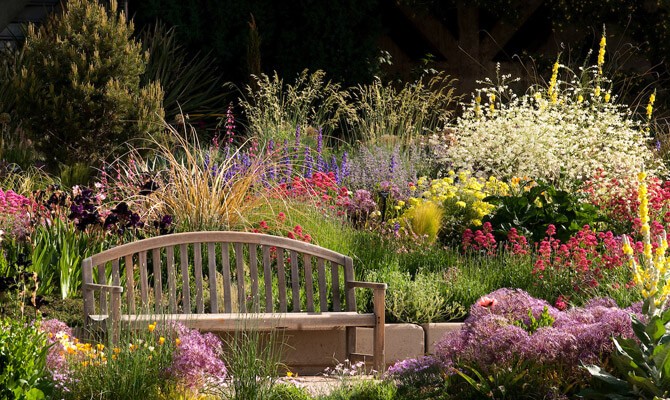
Gardens of the Globe
From botanical wonders in Australia to tranquil havens closer to home in Ireland, let this guide help you to discover some of the most glorious gardens around the world
By entering your details, you are agreeing to our terms and conditions and privacy policy. You can unsubscribe at any time.




